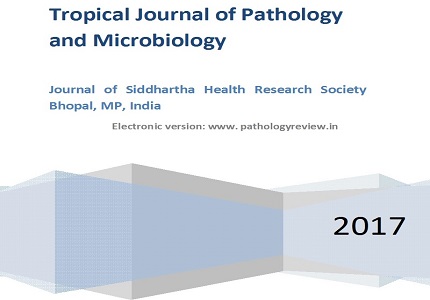Correlation of dipstick proteinuria with thrombocytopenia and leucopenia and its efficacy predicting the severity of kidney injury in dengue fever
Abstract
Introduction: Dengue fever is one of the global viral epidemics with more than 50 million cases reported per year with more than 20 thousand deaths every year. Dengue virus infection is transmitted by the bite of Aedes aegypti and Aedes albopictus mosquitoes. Dengue fever manifests as undifferentiated fever, dengue fever (DF), and dengue hemorrhagic fever (DHF).
Objective: This study was done in a tertiary care hospital in coastal region of Karnataka, India to correlate dipstick proteinuria with thrombocytopenia and leucopenia and its efficacy in predicting the severity of kidney injury in dengue fever.
Methods: The data has been obtained from the patient records of laboratory and medical records section of the hospital. Laboratory testing of patients admitted in the hospital with fever was done. Dengue fever was detected by the positivity to NS1 antigen, IgM and IgG. Patients coming with fever in the out-patient departments were excluded from the study. The hematological parameters and proteinuria were analysed. The Wilcoxon method (nonparametric) and the Student t-test (parametric) were used for statistical analysis. Descriptive statistics were compared using the chi-square test for the variables of gender, age and the clinical forms ofdengue. Hospital ethics committee clearance was obtained before starting the study.
Results: Proteinuria is seen to significantly correlate with thrombocytopenia and leucopenia in our study. However there was no significant correlation with leucopenia and thrombocytopenia in our study.
Conclusion: Hence injury to the kidney is more likely if there is presence of thrombocytopenia and leucopenia in patients with dengue fever. Thus severity of renal impairment in dengue fever can be predicted by presence of decreased total WBC count and decreased platelet count.
Downloads
References
World Health Organization: Dengue Haemorrhagic Fever: Diagnosis, treatment, prevention and control. 2nd ed. Geneva: World Health Organization 1997.
Monath TP. Dengue: the risk to developed and developing countries. Proc Natl Acad Sci U S A. 1994 Mar 29;91(7):2395-400.
Gubler DJ. Dengue and dengue hemorrhagic fever. Clin Microbiol Rev. 1998 Jul;11(3):480-96. [PubMed]
Gubler DJ, Meltzer M. Impact of Dengue and Dengue Haemorrhagic Fever on the developing world. Adv Virus Research 1999;53:35-70.
Platt KB, Linthicum KJ, Myint KS, Innis BL, Lerdthusnee K, Vaughn DW. Impact of dengue virus infection on feeding behavior of Aedes aegypti. Am J Trop Med Hyg. 1997 Aug;57(2):119-25.
Vanamali DR, Venugopal L, Yeshwanth P, Rampure D. A study on clinical, laboratory profile and outcome of dengue fever. Journal of Evolution of Medical and Dental Sciences. 2013 Dec 16; 2(50):9739-44.
Jain A, Shah AN, Patel P, Desai M, Somani S, Parikh P, Singhal R, Joshi D. A clinico-hematological profile of dengue outbreak among healthcare Professionals in a tertiary care hospital of Ahmedabad with analysis on economic impact. Nat J Comm Med. 2013; 4:286-90.
Kalayanarooj S, Vaughn DW, Nimmannitya S, Green S, Suntayakorn S, Kunentrasai N, Viramitrachai W, Ratanachu-eke S, Kiatpolpoj S, Innis BL, Rothman AL, Nisalak A, Ennis FA. Early clinical and laboratory indicators of acute dengue illness. J Infect Dis. 1997 Aug;176(2):313-21.
Shekar GC, Amaravadi A. Clinical, Biochemical and Hematological Profile in Dengue Fever. Int J Sci Stud2016;4(7):144-149.
Deshwal R, Qureshi MI, Singh R. Clinical and Laboratory Profile of Dengue Fever. J Assoc Physicians India. 2015 Dec;63(12):30-32. [PubMed]
Patel PM, Patel SK, Sabalpara MA, Shah CK, Shah NR. Study of hematological and biochemical changes in dengue fever at tertiary care hospital at Ahmedabad.Int J Med Sci Public Health 2016; 5: 1934-36.
Mittal H, Faridi MM, Arora SK, Patil R. Clinicohematological profile and platelet trends in children with dengue during 2010 epidemic in north India. Indian J Pediatr. 2012 Apr;79(4):467-71. doi: 10.1007/s12098-011-0586-7. Epub 2011 Oct 29.
Avarebeel S, Prahlad KA, Tabassum L. Study of clinical and demographic profile of dengue fever. J Evid Based Med Healthcare. 2014; 1(4):211-30.
Achalkar GV. Dengue: a clinic-pathological study of 50 cases.J Evol Med Den Sci 2013; 2(48):9380–5.
Ratageri VH, Shepur TA, Wari PK, Chavan SC, Mujahid IB, Yergolkar PN. Clinical profile and outcome of Dengue fever cases. Indian J Pediatr. 2005 Aug;72(8):705-6. [PubMed]
Ministry of Health & Family Welfare: Guidelines forClinical Management of Dengue Fever, Dengue Hemorrhagic Fever and Dengue Shock Syndrome.New Delhi, India: Govt of India; 2008. P 2-14.



 OAI - Open Archives Initiative
OAI - Open Archives Initiative


